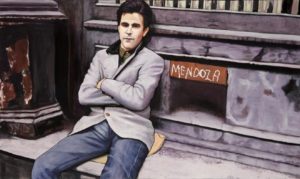The Oral History Center is pleased to release our life history interview with famed Chicano artist Joey Terrill: At the Forefront of Queer Chicano Art.
Joey Terrill is a Chicano artist and second-generation native of East Los Angeles. For nearly four decades, his paintings and prints have stood at the forefront of queer Chicano art, pushing the boundaries of form and cultural representation by exploring the confluences of race and sexuality. In the 1980s, his work expanded further to address the epidemic that was ravaging the arts community: AIDS. From silkscreens and collages to various styles of painting, his artwork has long given voice to the experience of gay Chicanos while simultaneously advocating for racial justice, gay liberation, and HIV awareness.

Joey’s artwork was featured in the Getty Center’s 2017 Pacific Standard Time: LA/ LA, an ambitious and far-reaching series of exhibitions across Southern California that explored Latin American and Latino art in dialogue with Los Angeles. In connection with this exhibition, The Getty Center sponsored life history interviews with selected Chicana/o and Latina/o artists, many of whom were showcased in the LA/ LA programs. These interviews, conducted by the Oral History Center at the University of California, Berkeley, aimed to document the lives and experiences of these artists amid the dynamic and changing art world of the West. Joey Terrill was one of the selected artists.
Hollywood itself would be hard-pressed to craft a more touching and heartfelt story than the life story told here in Joey Terrill’s oral history. Raised by a single mother in East Los Angeles, Terrill was heavily influenced by the burgeoning Chicano civil rights movement. He participated in the 1970 Chicano Moratorium as well as the United Farm Workers’ grape and lettuce boycotts during the late 1960s and early 1970s. As an openly gay man, he also linked calls of civil rights to gay liberation—a subject he began to explore in his art. From his “Maricon” photo series and two-issue zine “Homeboy Beautiful,” to his wide range of paintings, Terrill’s artwork created its own space within both the Chicano and gay art scenes. By the mid-1980s, Terrill’s work also began to address the AIDS epidemic, expressing outrage toward homophobia and government inaction, as well as paying tribute to many fallen friends. In recent years his work has also engaged with the experience of being a longtime HIV survivor.
For over four decades he has stood as one of the pioneers of queer Chicano art, and as a true gem of the Los Angeles arts community. Through his art and AIDS advocacy, Terrill has not only touched the lives of thousands, but has also served as a bridge to a new generation of artists, activists, and LGBTQ youth.